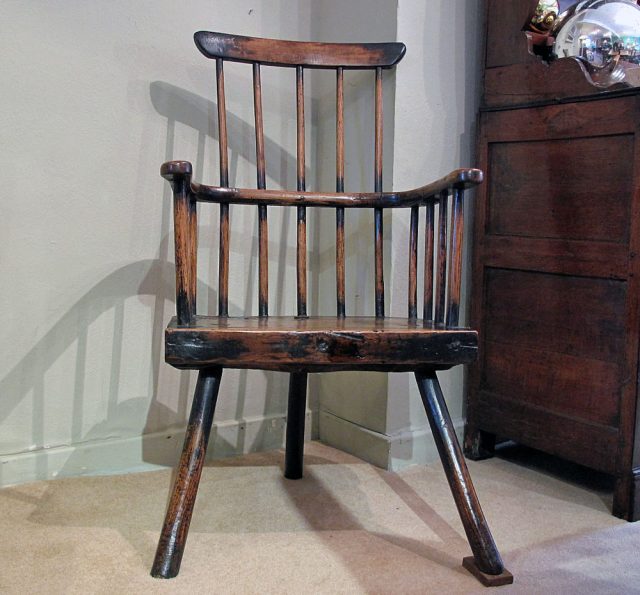
The big picture
As with methods of building cabinetry, there may well be as many potential takes on designing the kitchen for a particular house as designers who might be hired for the job. My own starting points include the clients’ preferences and the architectural context.
This kitchen is for a 1959 ranch originally built for a middle-class family. While decidedly modest (not shouting Hey, I’m cool! Look at me!), it incorporates some classic mid-century modern features. There’s an asymmetrical façade and stepped roof with generous overhangs at front and back. Inside, the kitchen cabinets are set into bulkheads. There’s streamline casing on windows and doorways. The floors are a mix of plain- and rift-sawn oak. The layout is split-level, with public rooms (living room and kitchen) on the main/entry floor, a short flight of stairs going up to the three original bedrooms and a full set of stairs to the walk-out basement, which has a laundry room, bedroom (added several years ago) and storage.
I don’t have access to pictures of the original kitchen, but in this case the missing information is immaterial. The clients didn’t want to recreate the kind of retro kitchen typical of local mid-century modest ranches.

Instead, as I’ve described in previous posts (here and here), they hoped to integrate the kitchen at least somewhat with the living room, as well as make it feel warmer and lighter. Replacing the hard, cold tile floor with oak run continuously from the living room will make a huge difference in perceived warmth. Skylights will bring in more natural light, and replacing the barely functional dark cabinets with clear-finished white oak will further enhance the warming and lightening effect.
I give clients all the pros and cons I can think of concerning every detail, from hinges to toekicks, and then I give my own opinion, assuring them that the decisions are ultimately theirs to make. I also think it’s important at least to broach the subject of resale appeal in kitchen design discussions. (Whether or not you have this discussion, you can be sure your clients’ family or friends will bring it up; at least if you’ve already run them through it, they will be better able to stand their ground in the face of know-it-all second-guessers.) Real estate agents and other pros have reams of advice, but I find the overwhelming majority of it useless (not to mention boring; who wants to live with a room designed for the lowest common denominator?). You can’t read the minds of future buyers. The fact is, an awful lot of people — perhaps the majority, these days — are determined to redo the kitchen when they buy a place, even if the existing kitchen was recently done; it’s a way of making their own statement. So if you’re jonesing for a kitchen based on the original cabinets of your 1915 bungalow, or your heart is set on a vision of teal, aquamarine and green…well, you can probably tell where this is going.


Cabinet design
Jenny and Ben have three children and really use their kitchen, so when considering materials, I put durability at the forefront. White oak faces would be fairly bullet-proof, and the grain’s a champ at distracting the eye from scratches, dents and other signs of wear. I suggested straightforward lines for the cabinets in the main preparation area. But wanting to distinguish the cabinets from the ubiquitous take on mid-century style produced by the more commercial shops in our area, I suggested a few tweaks: Instead of fully recessed kicks, we’d have a more “carpentery” design, with stiles going to the floor to accentuate the cabinets’ structure. Using adjustable European hinges and drawer slides, I could fit the cabinets with inset doors and drawer faces while staying within the budget. For optimal durability, I’ll have the cabinets sprayed with conversion varnish by my finishing subcontractor.
When it came to designing the shallow cabinets for the opposite wall, which forms the transition between entry area and living room to kitchen, I couldn’t bring myself to repeat the same design. I wanted these cabinets to be less “workerly,” more appropriate to this liminal space. I have a vivid memory of a stacking set of small, circular wooden boxes my parents had in the early 1960s; they may have been Japanese. I was mesmerized by their form and finish — enamel paint in mid-century versions of yellow, red and green, each with a rounded black rim. This built-in — part kitchen, part entry area — seemed an ideal place to incorporate such an aesthetic.
Milk paint
I suggested milk-paint for this cabinet because it lends itself to so many textural finishes. For the carcases, blocks of different colors will be framed by narrow solid lippings painted black. Full-overlay doors and drawer faces will have black edges. The kick will be fully recessed and painted black. The clients will choose a mix of colors and finish effects — perhaps single-color, perhaps layered — and I will have the whole thing sprayed with topcoats of conversion varnish for durability.



Cabinet hardware and counters
The door and drawer pulls (in the picture at the top of the post) are from Schoolhouse. Hanging open shelves over the sink area will retain the openness between the kitchen and living room while adding extra space for storage and decorative objects. The counters will likely be a dark gray soapstone.
— Nancy Hiller, author of Making Things Work





























